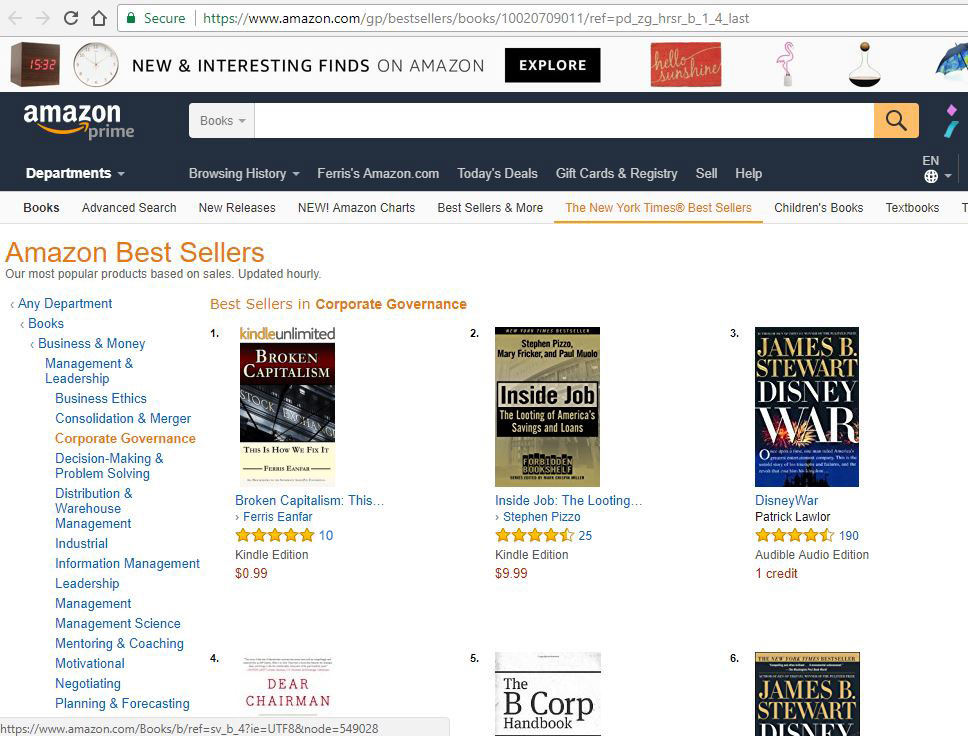Many people have a vague sense that the financial system is broken and corrupt, but they often don’t know how to explain exactly what is wrong. This is understandable because there is so much noise, false information and propaganda spewed in the mainstream media. Additionally, many politicians and corporate executives deliberately manipulate public perceptions of what they have done to the U.S. economy over the past several decades to avoid being held accountable. It’s important to have an accurate understanding of what precisely has happened to the U.S. financial system. So let’s take a brief stroll through modern U.S. banking history. . . .
1970: New York Stock Exchange Allows Member Firm IPOs. Prior to 1970, investment banks were structured as partnerships. Public trust was essential to earn business. Most importantly, their profits were generated by risking the partners’ own money, which ensured that they managed every transaction cautiously and responsibly. But all that changed after 1970. The NYSE allowed investment banks to sell their own stock to the public. This gave them access to billions of dollars of cash and stock-swap value that they could parlay into ever-larger mergers and acquisitions. This fueled a deal-making bonanza that led to the hyper-consolidation of the banking industry, concentrating enormous amounts of capital, wealth, and political power into the hands of a tiny number of monopolistic banking behemoths with an aggressive culture of risk-taking with other people’s money.
1982: Garn-St. Germain Depository Institutions Act. This legislation almost completely deregulated savings and loans (S&L) institutions and significantly watered down S&L accounting standards, which allowed them to enter new and riskier markets to compete with money market mutual funds. Of course, this was never the purpose of savings and loans (“thrifts”), but that didn’t stop short-sighted politicians from passing this legislation and blowing up the S&L industry between 1986 and the early 1990s. (High interest rates and inflation in the late 1970s and 1980s were problematic, too, but those factors did not cause the egregious fraud and risk-taking that could only occur after the 1982 Garn-St. Germain Act.)
1986-1990: “Section 20 Affiliates” Restriction is Abolished. Despite their crucial role as custodians of the core banking apparatus of the economy, their special access to Federal Reserve funds at discounted rates, and their special status as FDIC-insured institutions (all of which give commercial banks significant competitive advantages against money market mutual funds and other financial service providers), several commercial banks complained to Congress that they could not compete without repealing Section 20 of Glass-Steagall. Section 20 prevented commercial banks from owning or controlling non-bank affiliates that are “engaged principally” in investment-related activities. As a result of bank lobbying pressure, the Federal Reserve approved the request of those banks to participate in various investment banking and insurance underwriting activities, trading of commercial paper, municipal bonds, and mortgage-backed securities. This was the proverbial camel’s nose in the tent.
1996: Dismantling Glass-Steagall. The Federal Reserve “reinterpreted” the Glass-Steagall Act multiple times by the end of 1996, which collectively allowed consolidated bank holding companies (commingling retail banks and investment banks) to generate up to 25% of their revenues from investment-related activities. This was arguably the most significant action that set the precedent for the next decade of regulatory folly, leading directly to the 2008 catastrophe.
1998: Collapse of Long-Term Capital Management. The large hedge fund, Long-Term Capital Management (LTCM), collapsed from massive leverage and derivatives exposure, which demonstrated that complex trading of exotic derivatives (using over 100 times leverage in many cases) posed a catastrophic systemic risk to the entire global financial system. There were obvious lessons that should have been learned from this event, but they were substantially ignored by the most senior officials at the U.S. Treasury, Federal Reserve, and Congressional banking committees. Brooksley Born (Chairperson of the CFTC) and Sheila Bair (Chairperson of the FDIC) were laughed at and pushed out of their jobs when they tried to warn the Fed, Congress and Treasury that the same risks that destroyed LTCM were leading to an even bigger financial crisis in other sectors of the economy.
1998: Citicorp/Travelers Merger. Despite strong protest from many good-faith economists, financial industry analysts, and other industry stakeholders warning that this was a bad idea, Congress succumbed to relentless lobbying pressure and explicitly approved the Citigroup merger. Clearly illegal under the 1933 Glass-Steagall Act, this merger combined large retail banking, insurance underwriting, and investment banking operations into the world’s largest financial services conglomerate. Naturally, after this precedent was established, all the other ambitious financial corporations wanted to create their own systemically dangerous conglomerates.
1999: Gramm-Leach-Bliley Act. After protecting the banking system from destructive banking practices for over 60 years, the Glass-Steagall Act was repealed by the Gramm-Leach-Bliley Act. This was effectively a retroactive law to create the appearance of legal legitimacy for the Citigroup merger the previous year. It also legalized the Fed’s and Congress’ legally dubious previous “reinterpretations” of Glass-Steagall, which had been eroding the law’s efficacy for years. After 25 years and $300 million worth of lobbying and political campaign donations from the banking industry, Congress officially capitulated. This allowed retail and investment banks and other financial corporations to merge into giant conglomerates and commingle their assets in ways that increased the size, scope, and systemic risk of their operations. Shortly after serving on the Glass-Steagall demolition team, the U.S. Treasury Secretary was rewarded with a senior position at Citigroup and made $126 million while shuttling between Wall Street and Washington.
2000 to Present: Artificially Low Interest Rates. The Federal Reserve has maintained artificially low interest rates, which has fueled the borrowing bonanza that allowed financial institutions and the general public to accumulate massive, unsustainable amounts of debt. Despite the obvious fact that too much debt creates too much risk for the entire economy, the Fed has ignored all the warning signs for political reasons at the expense of the integrity and health of the entire global economy.
2000: Commodity Futures Modernization Act. This deceptively named legislation substantially repealed the regulation of derivatives, which enabled banks, commodities trading firms like the despised Enron Corporation, and other financial service companies to conceal the true size and risk of their debts and derivatives exposure from their counterparties and regulators. This legislation “modernized” the commodities trading industry by forcefully blocking effective regulations that would have prevented the credit default swap abuses that destroyed confidence in the entire financial system seven years later.
2001-2004: Net Capital Reductions & the “Consolidated Supervised Entities Program”. A series of complex regulatory changes collectively reduced the net capital required by banks and their broker-dealer subsidiaries. These adjustments created a strong bias for banks to leverage up on mortgage-backed securities (MBSs) because the MBSs were arbitrarily granted a lower risk weighting in their risk models. These changes also allowed banks and brokerage firms to essentially regulate themselves across a broad range of risky activities. This created powerful incentives for banks to ignore widespread mortgage industry fraud and to engineer every aspect of their retail banking, investment banking, insurance underwriting, and broker-dealer operations in ways that maximized their ability to gorge themselves on risky sub-prime mortgage-backed securities.
2008: Boom. We all saw the riveting drama unfold in the media; so there’s no need to rehash those familiar details here. However, after the financial crisis, many people optimistically hoped that these politicians would learn from their preceding egregious mistakes, but “learning” is not really what they care about. They’re more interested in preserving their role at the center of the regulatory protection racket that subsidizes their re-election campaigns. Now we continue into the post-2008 era of ongoing incompetence and planet-destroying negligence. . . .
2008: Emergency Economic Stabilization Act. This deceptively named legislation created the Troubled Asset Relief Program (“TARP”) and used trillions of taxpayer funds to purchase toxic securities and inject capital into the big banks and other large corporations without any meaningful accountability. Of course, this does not “stabilize” anything over the long-run. Rather than forcing the banks to properly reorganize under existing bankruptcy laws so that they can shed their irresponsible management that engaged in excessive risk-taking activities and dispose of their toxic assets in an orderly fashion without putting innocent taxpayers on the hook, the politicians chose to waste trillions of taxpayer funds to prop up banks and their wealthy shareholders. Predictably, this made them even more powerful by eliminating competition from smaller banks and financial service companies that could not compete with the government-backed behemoths. (Note: Despite the false doomsday propaganda from bad-faith politicians and special interest groups, bankruptcy does not destroy a company; it restructures it to operate more responsibly and/or facilitates the sale of its assets to more responsible management teams.)
2009: Public-Private Investment Program. Among a flurry of federal programs designed to prop up the biggest banks, the U.S. Treasury implemented the “Public-Private Investment Program” to purchase toxic assets from financial institutions backed by American taxpayer funds. As of today, this and many similar banking relief programs are part of an ongoing parasitic malignancy that is sucking all the life out of the U.S. economy while the biggest financial institutions balloon into even bigger and more systemically dangerous behemoths. These politicians continue to put ever-more taxpayer dollars at risk with these bailout programs, which of course inspires their special interest donors to continue financing their election campaigns.
2010: Dodd-Frank Act. The Dodd-Frank Act was pitched as the most ambitious financial reform legislation since FDR’s New Deal Era reforms in the 1930s. Dodd-Frank was supposed to “lift our economy” and “end too big to fail” and “promote financial stability,” all of which have been total fantasies at best, and deliberate lies more likely. Predictably, since 2008, too-big-to-fail financial corporations are much bigger today, large numbers of smaller community banks and asset management firms have been systematically destroyed, less competition has enabled the biggest banks to ratchet up their fees thereby hurting their customers, the entire financial system is much less stable, job growth is anemic, and the U.S. economy is in a permanent malaise.
Too Much Idiotic Bureaucracy; Not Enough Rational Regulation. Too much idiotic bureaucracy is killing smaller competitors who can’t afford to pay legions of lawyers and tax professionals to manage the exploding compliance bureaucracy. Too much idiotic regulation obscures the rules with endless gray areas, which makes it easier for the behemoths’ to exploit compliance loopholes and easier for politicians to use regulation as a political weapon to extort campaign contributions from their corporate prey. Politicians habitually (and often deliberately) fail to address the most basic problems where rational regulation would actually help: Too much debt, too much financial risk-taking, too much fraud, too much predatory behavior, and too little personal accountability for the senior executives and political officials who are responsible.
Every Toxic Step was Predicted, Predictable, and Preventable. At every fateful step along the path to the 2008 financial crisis there were specific politicians responsible for each criminally negligent decision to dismantle and block rational and obviously important regulations designed to protect the banking system from systemic collapse. Many people are on the record warning them long before each crisis occurred. In fact, if you look at the source of their campaign financing at the nonpartisan OpenSecrets.org site, you will see exactly how and why the integrity and actions of these politicians were distorted and corrupted. You probably won’t be surprised to know that the top-10 largest donors to all these politicians (Republicans and Democrats) were the biggest U.S. banks and financial institutions.
Pain and Suffering. It’s hard to ignore the pain and suffering that specific politicians have caused 100s of millions of people around the world today because of their bad-faith legislation, political partisanship, and incompetent regulation of the financial services sector. The destruction and re-distribution of trillions of dollars of wealth from unsuspecting taxpayers, retirement account holders, and novice investors around the world into the pockets of a tiny number of well-placed politicians, political campaigns, banks, traders, and corporate executives certainly meets the definition of a crime against humanity. Of course, none of the people responsible for these crimes are ever held accountable because they hide behind various legal and institutional walls (which they often create) that are designed to shield them from personal accountability.
Who Should We Blame Most? I’m asked this question frequently. It’s human nature to want to focus our anger on a single source. And it’s often doubly frustrating when the source of the problem seems so amorphous and systemic—like the blame is simultaneously everywhere and nowhere. Nevertheless, there should be a clear focal point for our anger: Without the incompetence, gross negligence, abuse of government power and taxpayer resources perpetrated by certain politicians over the past several decades, the banks would never be able to perpetuate their frauds and predatory behavior. Corporations are expected to be greedy because they represent their shareholders, but democratically elected government officials are supposed to represent their nation’s citizens. That’s why I blame politicians much more than I blame the banks and corporations.
This is Only the Tip of the Iceberg. Although I have compressed many of the most important facts and events from the past several decades of the U.S. banking system into this article, this is by no means an exhaustive account of all the disgusting mistakes and toxic decisions that a small number of U.S. politicians have unleashed upon the world. I encourage everybody to read my other articles (especially regarding the Federal Reserve and the U.S. political system’s structural problems), do their own research, and corroborate what you learn here and elsewhere with the nonpartisan OpenSecrets.org campaign financing database. That will confirm all your worst suspicions about many of the senior officials who “serve” you in the federal government.
From now on, if you ever hear anybody ask, “What’s really wrong with the banking system?” please point them to this article. We can never have too many people who know the truth.
About Ferris Eanfar
Ferris Eanfar has over 20 years of experience in technical, financial, media, and government intelligence environments. He has written dozens of articles and several books in the fields of Economics, Crypto-Economics, and International Political Economy, including Broken Capitalism: This Is How We Fix It and GINI: Capitalism, Cryptocurrencies & the Battle for Human Rights and the Global Governance Scorecard. Ferris is a cofounder of the Gini Foundation, which builds unique cryptocurrency systems to protect human rights, among other benefits; and the CEO of the AngelPay Foundation, a nonprofit financial services company with a mission to “return wealth and power to the creators of value.” To learn more about Ferris, please visit the About Ferris page.Visit Ferris on:

 Gini Website Coming Soon. We (
Gini Website Coming Soon. We (
